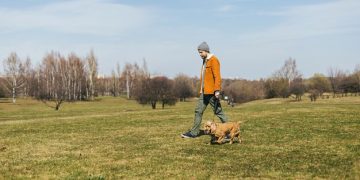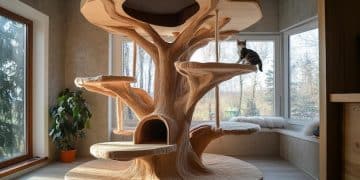Build a Backyard Agility Course: 5 Fun Obstacles for Your Dog
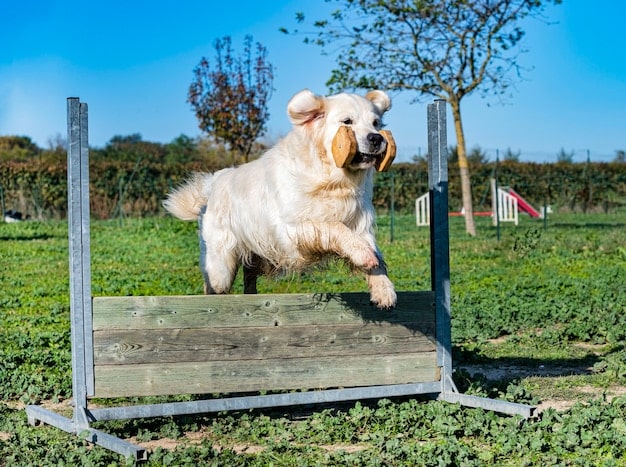
Anúncios
Building a backyard agility course can be a rewarding DIY project. This outdoor activity enhances your dog’s health, strengthens your bond, and offers mental stimulation through five easy-to-build obstacles.
Looking for a fun way to bond with your furry friend while keeping them active and mentally stimulated? Why not build a backyard agility course? It’s a fantastic DIY project that provides countless hours of entertainment for both you and your dog.
Anúncios
Why Build a Backyard Agility Course?
Creating a backyard agility course offers numerous benefits for both you and your canine companion. Not only does it provide a fun and engaging activity, but it also promotes physical fitness, mental stimulation, and a stronger bond between you and your dog.
A well-designed agility course challenges your dog’s coordination, balance, and problem-solving skills. Plus, it’s a great way to burn off excess energy and prevent boredom, which can lead to destructive behaviors. Let’s explore the different reasons why starting such a project can be a great idea.
Anúncios
Physical and Mental Benefits
Agility training is an excellent form of exercise for dogs, helping them maintain a healthy weight, improve cardiovascular health, and build muscle strength. Moreover, it keeps their minds sharp and engaged.
Strengthening the Bond with Your Dog
Working together to navigate the agility course enhances communication and trust between you and your dog. The positive reinforcement and teamwork involved create a deeper connection and understanding.
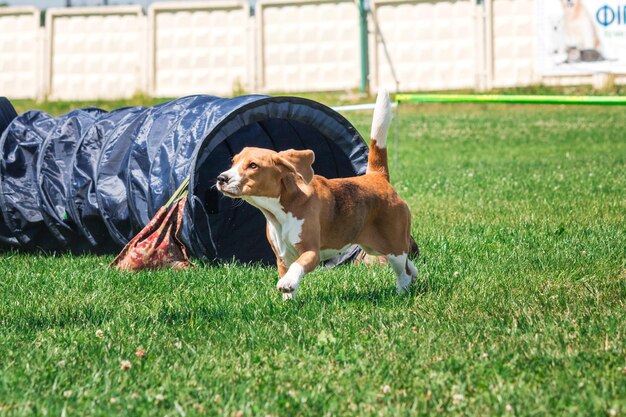
In summary, building an agility course in your backyard is a worthwhile investment in your dog’s overall well-being. It fosters both physical and mental health, strengthens your relationship, and provides hours of fun for both of you.
Planning Your Dog Agility Course
Before diving into the construction phase, careful planning is essential. Consider the available space, your dog’s size and abilities, and the materials you’ll need. By taking the time to plan, you can create a safe and enjoyable agility course tailored to your dog’s needs.
Think of the layout of your yard and the size of your dog to choose the perfect equipment. This preperatory stage is important for a successful project.
Assessing Your Backyard Space
Evaluate the available area to determine the size and layout of your agility course. Ensure there’s enough room for your dog to run freely and navigate the obstacles safely. Remember to keep the equipment according to your dog’s needs.
Considering Your Dog’s Size and Abilities
Choose obstacles that are appropriate for your dog’s size, breed, and athletic abilities. Opt for lower heights and wider spaces for smaller or less agile dogs, and gradually increase the difficulty as they progress. With patience, you can gradually increase the difficulty as your dog progresses.
With proper planing, you can create a secure and stimulating environment that enhances your dog’s physical and mental well-being. It ensures every jump and weave is designed to meet the unique needs of your best friend.
Obstacle 1: The Jump Hurdle
A jump hurdle is one of the simplest and most versatile obstacles you can include in your backyard agility course. It’s easy to build and can be adjusted to different heights, making it suitable for dogs of all sizes and skill levels.
Building a jump hurdle is a fun and rewarding project that will provide hours of entertainment for you and your dog. Let’s get started!
Materials You’ll Need:
- PVC pipes (1-inch diameter)
- PVC fittings (T-connectors, elbow connectors, end caps)
- Measuring tape
- Saw or PVC pipe cutter
- Sandpaper (optional)
- Paint (optional, for decoration)
Construction Steps
- Cut the PVC pipes into the desired lengths for the uprights, crossbar, and base supports.
- Assemble the base using T-connectors and elbow connectors to create a stable foundation.
- Attach the uprights to the base using T-connectors.
- Connect the crossbar to the uprights using T-connectors, ensuring it can be easily adjusted or removed.
- Sand any rough edges and paint the jump hurdle if desired.
With a jump hurdle in your backyard agility course, your dog will enjoy practicing their jumping skills while improving coordination and fitness. Remember to start with low heights and gradually increase the challenge as your dog becomes more confident.
Obstacle 2: Weave Poles
Weave poles are a classic agility obstacle that challenges your dog’s coordination, focus, and ability to follow commands. Building your own set of weave poles is a relatively simple DIY project that can add a lot of fun to your backyard agility course.
Building your own weave poles adds a unique mix of movement and mental effort that strengthens the bond between you and your furry friend. Let’s see how to do it:
Materials Required
- PVC pipes (1-inch diameter)
- PVC fittings (T-connectors, end caps)
- Measuring tape
- Saw or PVC pipe cutter
- Sand or gravel (for weighting the base)
- Drill
- Rope or string
Assembly Instructions
- Cut the PVC pipes into equal lengths for the poles (usually 3-4 feet tall).
- Create a base for each pole using T-connectors and end caps, filling the base with sand or gravel for stability.
- Drill a hole near the top of each pole for threading the rope or string.
- Thread the rope or string through the holes in the poles, spacing them evenly apart.
- Secure the rope or string to the first and last poles to create a continuous weaving path.
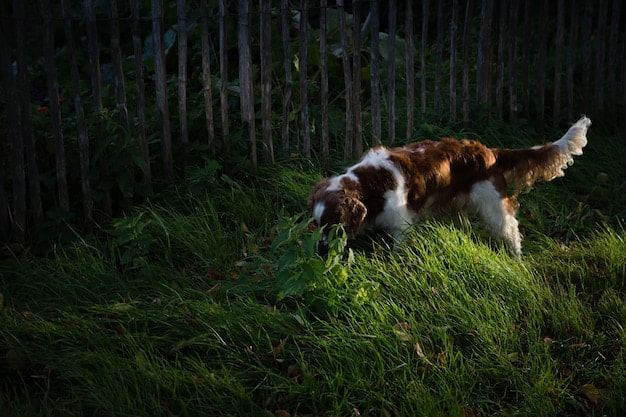
By incorporating weave poles into your backyard agility course, you’ll provide your dog with a challenging and rewarding activity that enhances their physical and mental skills. Practice, patience, and positive reinforcement are key to helping your dog master this fun obstacle.
Obstacle 3: The Tunnel
Adding a tunnel to your backyard agility course introduces an element of adventure and excitement for your dog. Tunnels are not only fun but also help build your dog’s confidence and willingness to explore new environments.
Tunnels are a fun and relatively simple DIY project that will add a lot of excitement to the dog’s agility course. Let explore the creation process.
Choosing the Right Tunnel
You can purchase a commercially made agility tunnel or create your own using flexible materials like dryer vent tubing or heavy-duty fabric. Ensure the tunnel is wide enough for your dog to move through comfortably and long enough to present a challenge.
Setting Up the Tunnel
Place the tunnel on a flat, grassy surface and secure it in place using tent stakes or sandbags to prevent it from rolling or shifting during use. You can create a straight tunnel or introduce curves and bends to increase the difficulty.
After completing these steps, enjoy watching your dog conquer this fun addition to their agility course!
Obstacle 4: Pause Table or Platform
A pause table or platform is a unique addition to your backyard agility course. It teaches your dog to maintain focus and self-control, even in the midst of excitement. This exercise strengthens their obedience skills.
It is also incredibly easy to build. Keep reading the following tips:
Constructing a Simple Platform
You can create a basic pause table using a sturdy piece of wood or a plastic platform. Ensure the surface is non-slip to provide your dog with stability and confidence. The platform should be tall enough for your dog to comfortably stand on but not so high that it poses a risk of injury.
Training on the Pause Table
- Introduce your dog to the pause table gradually, using positive reinforcement and treats.
- Encourage them to jump onto the platform and remain there for a few seconds, gradually increasing the duration as they become more comfortable.
- Use a clear verbal command to signal when your dog should stay on the platform and when they can come off.
With consistent training and positive reinforcement, your dog will learn to enjoy their time on the pause table, developing valuable self-control and focus skills that extend beyond the agility course.
Obstacle 5: Tire Jump
Adding a tire jump brings a unique challenge to your backyard agility course. The tire jump helps improve your dog’s jumping accuracy and coordination, enhancing their athletic skills.
The best part is that it is an easy and economic option. Let’s go over the construction process.
Finding a Suitable Tire
Locate a safe, used tire from a local tire shop or recycling center. Ensure it is free from sharp edges, wire, or other hazards. Clean the tire thoroughly before incorporating it into your agility course.
Creating the Jump
Hang the tire from a sturdy frame or suspend it between two posts using ropes or chains. Adjust the height of the tire to match your dog’s jumping abilities, starting low and gradually increasing the challenge as they progress. Make sure the tire is stable and secure to prevent accidents.
By mastering the tire jump, your dog will improve their coordination, jumping accuracy, and overall agility skills. Remember to prioritize safety and positive reinforcement throughout the training process.
| Key Point | Brief Description |
|---|---|
| 🐶 Jump Hurdle | A simple obstacle made of PVC pipes. |
| 🌀 Weave Poles | Poles through which dogs weave to improve coordination. |
| 🕳️ Tunnel | Adds adventure and boosts confidence. |
| 🛑 Pause Table | Teaches focus and self-control. |
frequently Asked Questions
▼
The required space for a backyard agility course hinges on the number and size of the obstacles. A modest setup may need around 30×40 feet, but larger courses will need more. Measure your space for a course that fits comfortably.
▼
Safety is pivotal when building an agility course. Ensure all equipment is sturdy and free from sharp edges. The area should be clear and flat to prevent injuries, with grass as a soft landing surface.
▼
Introduce your dog to the agility course slowly and positively. Start with one obstacle, using treats and praise to guide them. Keep training sessions short and fun, and don’t rush them through it.
▼
Carefully select materials for your DIY obstacles. PVC pipes are great for jumps and weave poles, but avoid materials with sharp edges. Consider weather-resistant options to ensure the course lasts longer.
▼
Train your dog on the agility course a few times a week, ensuring sessions are short and engaging. Monitor your dog for signs of fatigue and take breaks. Consistency and positive reinforcement will yield results.
Conclusion
With careful planning and a little DIY effort, you can build a backyard agility course that provides endless fun and benefits for your dog. By choosing the right obstacles and following safety guidelines, you’ll create a stimulating environment that promotes physical fitness, mental agility, and a stronger bond with your furry friend.


